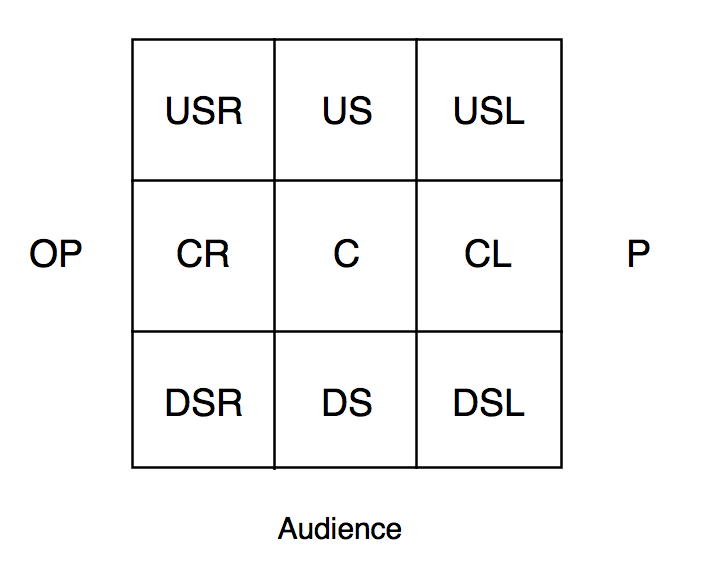Today we learnt about Aboriginal theatre. We watched a short clip with depicted a story about a frog who drank all of the water and then the Aboriginal man and the animals had a meeting and tried ways to get the water back. They decided to make the frog laugh and no one could do so until an eel did a really funny dance and then they got all the water back (yay!)
We then had to get into groups and modernise this scene while still keeping the original aspects of the story. I honestly don't remember what my group did but I know it wasn't very good. Our feedback was to use our time more wisely and think more extensively about the task so we weren't forced to improvise a scene when the time came to perform it.
Type of Performing Spaces
Ins and Outs of the Stage Vocabulary
On Stage- not on stage so not visible to the audience
Off Stage- on stage so visible to the audience
Wings- the sides of a theatre stage out of view from the audience
Line of Sight- a normally unobstructed line-of-sight between an intended observer (or spectator)(i.e. audience) and a stage, arena or monument.
Cyclorama- a circular picture of a 360˚ scene, viewed from inside
Back Cloth-
Trap Door- a hinged or removable panel in a floor, ceiling, or roof, usually used for surprise entrances and exits.
House Curtain- curtains at the very front of the stage
Curtain Call- the appearance of one or more performers on stage after a performance to acknowledge the audience's applause.
Fine Curtain-
Curtain Line- the line marking the position of the curtain when closed
Backstage- in or around the area behind the stage in a theatre, esp. the wings or dressing rooms.
Scenery Dock-
Bump In/Out- the process or preparing the theatre for a particular production or packing up the theatre after a production. It includes building the set, introducing props and costumes, and rigging the lights.
Calls-
Dressing Rooms- a room in which performers before, after, or during their performance.
Wardrobe Room-
Green Room- a room in the theatre in which performers can relax when they are not performing.
Types of Performance Spaces- Stage Positions
21/2/14- Week 4
Today we learnt about the different positions of the stage. They are:
- US- Upstage
- USR- Upstage Right
- USL- Upstage Left
- C- Centre
- CR- Centre Right
- CL- Centre Left
- DS- Downstage
- DSR- Downstage Right
- DSL- Downstage Left
- P- Prompt
- OP- Opposite Prompt
Stage Positions
- US- Upstage
- USR- Upstage Right
- USL- Upstage Left
- C- Centre
- CR- Centre Right
- CL- Centre Left
- DS- Downstage
- DSR- Downstage Right
- DSL- Downstage Left
- P- Prompt
- OP- Opposite Prompt
Types of Performance Spaces- Created/Found Space
14/2/14 Week 2
The Elements of Drama
- Character- the representing of a three dimensional human being with a particular personality, characteristic and background.
- Role- the representing of a point of view, and identifying with a set of values and attitudes.
- Status- a character's position and standing, weighty or otherwise, within any grouping of people; e.g. high status as opposed to low status.
- Conflict- characters are in conflict when they have opposing purposes or objectives within the drama.
- Dramatic tension- the problems faced by a character: their relationships, the creation of surprise, the unfolding of mystery.
- Focus- the performer's focus in creating concentration and belief. The audience's focus on the dramatic situation.
- Place- the setting of the dramatic action.
- Time- the period in which dramatic action takes place.
- Situation- the circumstances the characters are in
- Space- the stage area, the spatial design of the set and the arrangement of the physical elements of the performance (e.g. where the actors are placed)
- Language- the verbal and non-verbal forms in which the dramatic action is conveyed.
- Moment- the control and manipulation of key moments in the dramatic actions (e.g climax.)
- Sound- the use of aural devices to enhance the performance.
- Rhythm- the manipulation of time through pace and tempo.
- Structure- the framework through which the content of the drama is presented.
- Symbols- the visual imagery of language, movement, gesture, objects and staging used to reinforce meaning.
- Atmosphere- the feeling or mood created by, and emerging through, the dramatic action.
- Dramatic meaning- the sum total of what is communicated between the performers and the audience.
- Audience engagement- the ultimate purpose of all the elements of drama.
Types of Performance Spaces
 The Proscenium Stage
The Proscenium Stage- Can use lots of scenery for "realistic" visual "picture frame"
- More realism possible
- Easier to light (from one direction)
- Room backstage
- Uses traditional stage areas (upstage, downstage)
- Sydney Lyric Theatre
- Everest Theatre
- Sydney Opera House
- Sydney Theatre
- Drama Theatre
 |
Thrust Stage |










